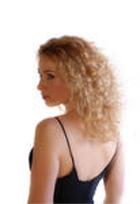
One of the primary cause of hair loss is a high amount of the male hormone, dihydrotestosterone (DHT) within the hair follicle. DHT is produced from testosterone in the prostate, various adrenal glands, and the scalp. After a period of time, an over abundance of DHT causes the hair follicle to degrade and shortens the active phase of the hair. The most important cause of hair loss is inadequate nutrition. Even a partial lack of almost any nutrient may cause hair to fall. But hair grows normally after a liberal intake of these vitamins. A high protein and and an iron rich diet is recommended for hair loss. An adequate intake of raw vegetables, fresh fruits, salads, green leafy vegetables should be included in the diet on a regular basis. Another important cause of falling hair is stress, such as worry, anxiety and sudden shock. Stress leads to a severe tension in the skin of the scalp. This adversely affects the supply of essential nutrition required for the healthy growth of hair. General debility, caused by severe or long standing illnesses like typhoid, syphilis, chronic cold, influenza and anaemia, also gives rise to hair disorders. It makes the roots of the hair weak, resulting in falling of hair. An unclean condition of the scalp can also cause loss of hair. This weakens the hair roots by blocking the pores with the collected dirt. Heredity is another predisposing factor which may cause hair to fall. Women require 60 grams, men 80 to 90 grams, adolescent boys and girls 80 to 100 grams of protein. It is supplied by milk, buttermilk, yogurt, soyabean, eggs, cheese, meat and fish. A deficiency of some of the B vitamins, of iron, copper and iodine may cause hair disorders like falling of hair and premature greying of hair. Scalp reduction is performed on patients with well-defined bald spots in the crown area of the scalp. It is sometimes done in conjunction with hair transplantaion to reduce the size of the bald scalp, especially in patients who do not have enough donor hair to cover the bald areas. Silicon bags are inserted beneath an area of hairy scalp and gradually inflated with saline water over a six-week period. This causes the hair-bearing skin to stretch, thus increasing the amount of hair-bearing scalp. After removing the bags, expanded hair bearing skin is lifted and moved to an adjacent bald area where a similar sized patch of scalp has been excised. For women, hair loss is different. There is no set pattern for womens androgenic hair loss, which like MPB, occurs in the overwhelming majority of cases. Women can suffer from alopecia totalis and alopecia universalis just like men. Women can experience patch baldness for the same reasons as men (stress, poor nutrition, etc.), as well as due to hormonal changes from pregnancy and certain eating disorders. However, like men, the hair will generally grow back. The chief difference in womens androgenic hair loss from mens (both are hormone related) is that women tend to experience thinning that occurs in no particular pattern or part of the scalp. Unlike men, the scalp may not actually be totally denuded of hair, just thin to the point where the scalp is visible. Like men, however, the resulting hair loss is generally irreversible. New hair resulting from minoxidil use may be thinner and shorter than previous hair. But there can be enough regrowth for some people to hide their bald spots and have it blend with existing hair. New hair stops growing soon after you discontinue the use of minoxidil. If you experience minimal results within six months, your doctor may recommend discontinuing use. Side effects can include irritation of the scalp. Anthralin (Drithocreme). Available as either a cream or an ointment, anthralin is a synthetic, tarry substance that you apply to your scalp and wash off daily. It's typically used to treat psoriasis, but doctors can prescribe it to treat other skin conditions. Anthralin may stimulate new hair growth for cases of alopecia areata.
It is good to shampoo your hair--we recommend at least three times a week. This helps to remove dirt and buildup on the hair that can deteriorate the condition of your scalp. When shampooing, it is very important that you pay attention to cleansing your hair, your scalp and your hair line. Frequently shampooing can dry out your hair and, therefore, must be followed by the use of a moisturizing conditioner. It is very important to work the conditioner through all of your hair and leave it in for three to five minutes. Again, many people misapply and misuse conditioner by not working it through to the ends of the hair and not leaving it on long enough. Excessive exposure to the sun can damage your hair by inducing oxidation of the sulfur molecules within the hair shaft, leaving the hair weak, brittle, dry and faded. People who bleach or lighten their natural hair color may also notice slight color changes in their hair when it is exposed to sun.
The innermost layer of hair is called the medulla and reflects light giving hair the various color tones it has. That's why hair color looks a lot different in sunlight than it does in the shade. Whether you have straight or curly hair depends on the shape of the cortex. If the cross section of the cortex is round you will have straight hair, if the cortex is oval shaped you will have curly or wavy hair. About 90 percent of the hair on a person's scalp is growing at any one time. The growth phase lasts between two and six years. Ten percent of the hair is in a resting phase that lasts two to three months. At the end of its resting stage, the hair is shed. When a hair is shed, a new hair from the same follicle replaces it and the grow-ing cycle starts again.

Terms explainingAlopecia Areata
- Alopecia areata is a hair loss condition which usually affects the scalp. It can, however, sometimes affect other areas of the body.
Hair loss
- A progressive, diffuse loss of scalp hair in men that begins in the twenties or early thirties, depends on the presence of the androgenic hormone testosterone, and is caused by a combination of genetic and hormonal factors. Also called androgenetic alopecia.
Hair transplantation
- Hair transplantation is a surgical procedure used to treat baldness or hair loss (alopecia). Typically, tiny patches of scalp are removed from the back and sides of the head and implanted in the bald spots in the front and top of the head.
Protein
- Important building blocks of the body, composed of amino acids, involved in the formation of body structures and controlling the basic functions of the human body.
- Complex organic molecules made up of amino acids. Proteins are basic components of all living cells and are therefore among the principal substances that make up the body.
Ringworm
- The term "ringworm" refers to fungal infections that are on the surface of the skin. The early belief was that the infection was due to a worm, which it is not, although the name has stuck. Some of these fungi produce round spots, but many do not.
Thyroid
- A gland in the throat that produces hormones that regulate growth and metabolism.
- A large gland in the neck that functions in the endocrine system. The thyroid secretes hormones that regulate growth and metabolism.
Alopecia
- A hair loss, baldness, and epilation.
- Alopecia, also called hair loss, baldness, and epilation, is a common side effect of chemotherapy and radiation therapy.
Baldness
- A progressive, diffuse loss of scalp hair in men that begins in the twenties or early thirties, depends on the presence of the androgenic hormone testosterone, and is caused by a combination of genetic and hormonal factors. Also called androgenetic alopecia.
Biotin
Follicles
- A follicle (from the Latin folliculus) is a term to describe a small spherical group of cells containing a cavity.
Grafts
- To transplant or implant surgically into a bodily part to replace a damaged part or compensate for a defect.
Hormone
- A substance, usually a peptide or steroid, produced by one tissue and conveyed by the bloodstream to another to effect physiological activity, such as growth or metabolism.
Scalp
- The skin covering the top of the human head with its attached hair.
Stress
- Importance, significance, or emphasis placed on something.
- The relative force with which a sound or syllable is spoken.
- Accent or a mark representing such emphasis or force.
- An applied force or system of forces that tends to strain or deform a body.
- A mentally or emotionally disruptive or upsetting condition occurring in response to adverse external influences and capable of affecting physical health, usually characterized by increased heart rate, a rise in blood pressure, muscular tension, irritability, and depression.
- A state of extreme difficulty, pressure, or strain.
- A physical and psychological response that results from being exposed to a demand or pressure.
Testosterone
- A white crystalline steroid hormone, C19H28O2, produced primarily in the testes and responsible for the development and maintenance of male secondary sex characteristics. It is also produced synthetically for use in medical treatment.
|